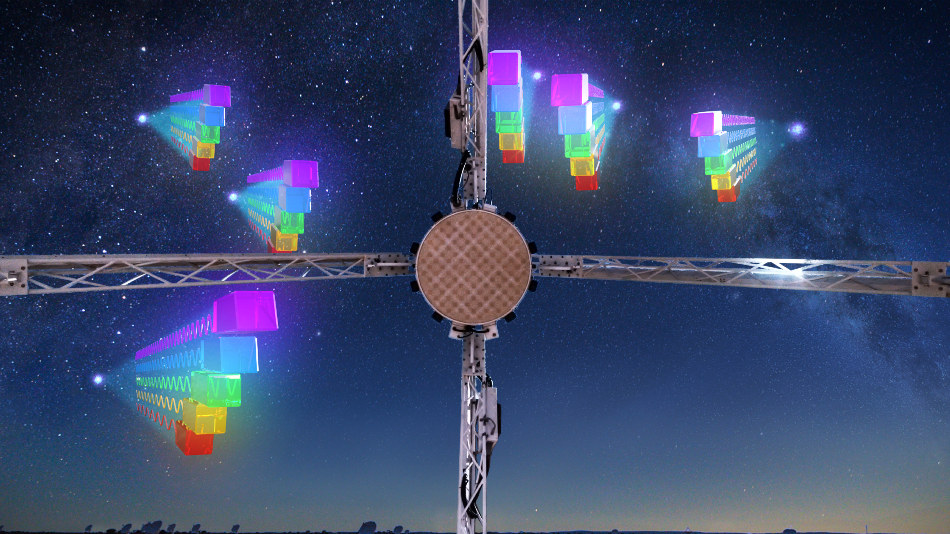May 28 2020
Using mysterious fast radio bursts, astronomers have successfully solved a decades-old enigma of the “missing matter,” which was long projected to be present in the Universe but never identified, until now.
 CSIRO’s ASKAP telescope continues to detect new FRBs, adding to the catalogue of these mysterious objects. Image Credit: International Centre for Radio Astronomy Research and CSIRO/Alex Cherney.
CSIRO’s ASKAP telescope continues to detect new FRBs, adding to the catalogue of these mysterious objects. Image Credit: International Centre for Radio Astronomy Research and CSIRO/Alex Cherney.
The scientists have now discovered that the enormous space between the galaxies and stars contains all the missing “normal” matter, as explained recently in the Nature journal.
According to Jean-Pierre Macquart, the study’s lead author and Associate Professor from the Curtin University node of the International Centre for Radio Astronomy Research (ICRAR), astronomers have been looking for the missing matter for nearly three decades.
We know from measurements of the Big Bang how much matter there was in the beginning of the Universe. But when we looked out into the present Universe, we couldn’t find half of what should be there. It was a bit of an embarrassment.
Jean-Pierre Macquart, Study Lead Author and Associate Professor, Curtin University, International Centre for Radio Astronomy Research
“Intergalactic space is very sparse,” Macquart added. “The missing matter was equivalent to only one or two atoms in a room the size of an average office. So it was very hard to detect this matter using traditional techniques and telescopes.”
The scientists used the phenomenon called fast radio bursts to directly identify the missing matter. The fast radio bursts are essentially short flashes of energy that seem to arise from haphazard directions in the sky and persist for only milliseconds.
Researchers do not know what causes these radio bursts but it should involve a remarkable amount of energy, which is similar to the amount produced by the Sun in 80 years. The fast radio bursts have been difficult to detect since astronomers are clueless about where and when to look for them.
According to Associate Professor Macquart, the researchers used fast radio bursts as “cosmic weigh stations” to identify the missing matter.
The radiation from fast radio bursts gets spread out by the missing matter in the same way that you see the colours of sunlight being separated in a prism.
Jean-Pierre Macquart, Study Lead Author and Associate Professor, Curtin University, International Centre for Radio Astronomy Research
Macquart continued, “We’ve now been able to measure the distances to enough fast radio bursts to determine the density of the Universe. We only needed six to find this missing matter.”
In this case, the missing matter is a “normal” matter or baryonic—similar to the neutrons and protons that constitute planets, stars, and all human beings.
“Normal” matter is different from dark matter, which continues to be a mystery and is responsible for around 85% of the overall matter present in the Universe.
J. Xavier Prochaska, the study’s co-author and Professor from UC Santa Cruz, informed that they have searched in vain for this missing matter with their biggest telescopes for over two decades.
“The discovery of fast radio bursts and their localisation to distant galaxies were the key breakthroughs needed to solve this mystery,” he added.
According to Associate Professor Ryan Shannon, another co-author of the study from the Swinburne University of Technology, the key lies in the telescope used—the Australian Square Kilometre Array Pathfinder (ASKAP) radio telescope of CSIRO.
ASKAP both has a wide field of view, about 60 times the size of the full Moon, and can image in high resolution. This means that we can catch the bursts with relative ease and then pinpoint locations to their host galaxies with incredible precision.
Ryan Shannon, Study Co-Author and Associate Professor, Swinburne University of Technology
“When the burst arrives at the telescope, it records a live action replay within a fraction of a second,” stated Dr Keith Bannister from Australia’s national science agency, CSIRO, who developed the pulse capture system used in this study.
“This enables the precision to determine the location of the fast radio burst to the width of a human hair held 200 m away,” he added.
Associate Professor Macquart further added that the researchers had identified the association between the distance of a fast radio burst and the way the burst spreads out while traveling through the Universe.
“We’ve discovered the equivalent of the Hubble-Lemaitre Law for galaxies, only for fast radio bursts. The Hubble-Lemaitre Law, which says the more distant a galaxy from us, the faster it is moving away from us, underpins all measurements of galaxies at cosmological distances,” Macquart concluded.
The fast radio bursts applied in this work were detected through ASKAP, which is based at the Murchison Radio-astronomy Observatory in outback Western Australia. The international researchers involved in the discovery included astronomers from Chile, Australia, and the United States.
ASKAP is a forerunner for the upcoming Square Kilometre Array (SKA) telescope. The SKA could visualize massive numbers of fast radio bursts, providing astronomers more potential to analyze the formerly imperceptible structure in the Universe.
Missing Matter
Astronomers have used a network of mysterious fast radio bursts (FRBs) to detect half of the Universe’s normal matter, missing until now. Video Credit: ICRAR with some footage supplied by CSIRO/Alex Cherney, ESO/y. Beletsky and ESO/R. Wesson.
Journal Reference:
Macquart, J.-P., et al. (2020) A census of baryons in the Universe from localized fast radio bursts. Nature. doi.org/10.1038/s41586-020-2300-2.